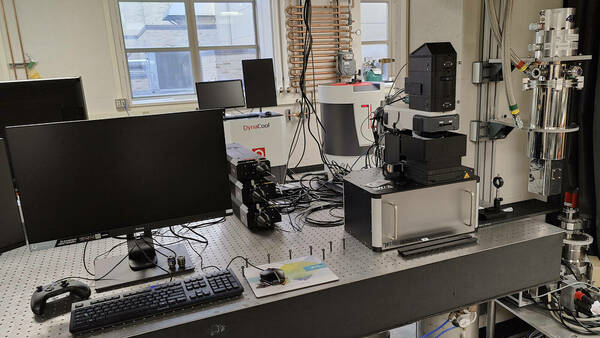WITec alpha300R Raman Spectrometer

Applications
Raman Spectroscopy is a non-destructive chemical analysis technique which provides detailed information about chemical structure, phase and polymorphy, crystallinity and molecular interactions. It is based upon the interaction of light with the chemical bonds within a material.
Raman spectroscopy relies upon inelastic scattering of photons, known as Raman scattering. A source of monochromatic light, usually from a laser in the visible, near infrared, or near ultraviolet range is used, although X-rays can also be used. The laser light interacts with molecular vibrations, phonons or other excitations in the system, resulting in the energy of the laser photons being shifted up or down. The shift in energy gives information about the vibrational modes in the system. Infrared spectroscopy typically yields similar yet complementary information.
Typically, a sample is illuminated with a laser beam. Electromagnetic radiation from the illuminated spot is collected with a lens and sent through a monochromator. Elastic scattered radiation at the wavelength corresponding to the laser line (Rayleigh scattering) is filtered out by either a notch filter, edge pass filter, or a band pass filter, while the rest of the collected light is dispersed onto a detector.
Location
220 Nieuwland Science Hall - Complex Quantum Matter Laboratory
Contact person: Bence G Markus
Capabilities
Available excitations:
| Wavelength (nm) | Cutoff (cm-1) | Maximum power (mW) |
| 457 | 10 | 16 |
| 532 | 10 | 56 |
| 633 | 80 | 28 |
Available objectives:
| Magnification | Type | NA | Working distance (mm) |
| 10x | Zeiss EC "Epiplan" | 0.25 | 11.0 |
| 20x | Olympus SLMPLan | 0.35 | 21.0 |
| 50x | Zeiss LD "Epiplan-Neofluar" | 0.55 | 9.1 |
| 50x | Olympus SLMPLan | 0.45 | 15.0 |
| 100x | Zeiss EC "Epiplan-Neofluar" | 0.90 | 1.0 |
| open space | coupling for external cryostat | lens dependent |
Available gratings:
- 600 gr/mm
- 1800 gr/mm
- 2400 gr/mm
Related work
- B. G. Márkus, P. Szirmai, K. F. Edelthalhammer, P. Eckerlein, A. Hirsch, F. Hauke, N. M. Nemes, J. C. Chacón-Torres, B. Náfrádi, L. Forró, T. Pichler, F. Simon: Ultralong spin lifetime in light alkali atom doped graphene, ACS Nano 14, 7492-7501 (2020)
- P. Szirmai, B. G. Márkus, J. C. Chacón-Torres, P. Eckerlein, K. F. Edelthalhammer, J. M. Englert, U. Mundloch, A. Hirsch, F. Hauke, B. Náfrádi, L. Forró, C. Kramberger, T. Pichler, F. Simon: Characterizing the maximum number of layers in chemically exfoliated graphene, Scientific Reports 9, 19480 (2019)